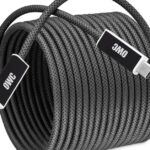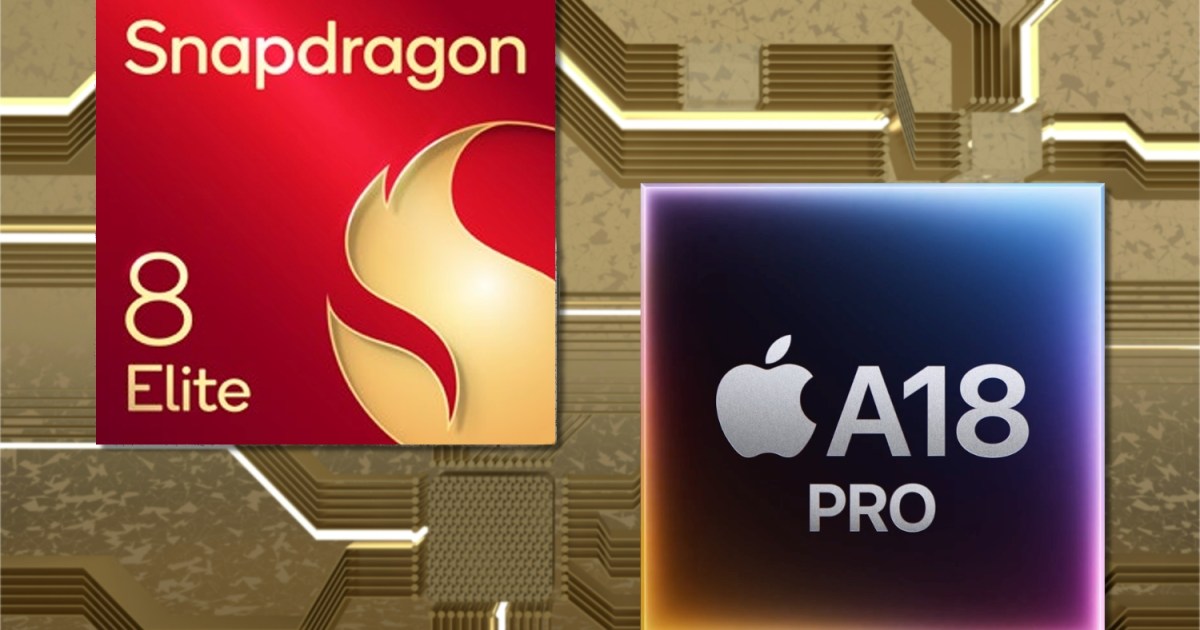Qualcomm’s Snapdragon 8 Elite is an exciting new mobile platform that’s destined to power many of next year’s flagship smartphones. The improvements Qualcomm has made in this year’s chip are highlighted by the fact that the chipmaker has dropped its traditional “Gen” designations to give the fourth-generation chip an identity all its own.
While the Snapdragon 8 Elite has already started showing up in some more niche flagships like the Realme GT 7 Pro, we likely won’t really get a taste of what it can do until more mainstream players like OnePlus and Samsung bring it to their phones. The OnePlus 13 has already been announced and will probably hit North American shores early next year. There’s also little doubt that the new chip will also be at the core of Samsung’s Galaxy S25 lineup, likely powering new Galaxy AI features and bringing the S25 Ultra’s cameras to new heights.
On the other side of the ring, Apple continues to flex its chipmaking muscles with the A18 Pro, which is at the heart of this year’s iPhone 16 Pro. We don’t have to wait to see what that chip is capable of, however, as Apple has already (mostly) put its best foot forward with Apple Intelligence and new computational photography features.
While it’s hard to compare the Snapdragon 8 Elite and A18 Pro on equal footing since both are used in fundamentally different mobile platforms, their differences raise some interesting questions. Most notably, does either piece of silicon give one platform a significant advantage over the other, or is it more about what phone makers do with the capabilities that are available to them? Let’s dig in and find out.
Snapdragon 8 Elite vs. Apple A18 Pro: specs
| Specs | Snapdragon 8 Elite | Apple A18 Pro |
|---|---|---|
| Part number | SM8750-AB | A18 Pro |
| Process | 3nm (N3E) | 3nm (N3E) |
| CPU | Qualcomm Oryon CPU 64-bit Architecture 2 prime cores, up to 4.32GHz 6 performance cores, up to 3.53GHz |
Apple CPU 64-bit Architecture 2 High-Performance cores, up to 4.04GHz 4 Efficiency Cores, up to 2.2GHz |
| GPU | Adreno 830 GPU Support for Unreal Engine 5.3 Nanite Adreno Frame Motion Engine 2.1 Snapdragon Game Super Resolution Snapdragon Game Post-Processing Accelerator HDR gaming (10-bit color depth, Rec. 2020 color gamut) Snapdragon Shadow Denoiser API support: OpenGL ES 3.2, OpenCL 3.0 FP, Vulkan 1.3 Hardware-accelerated H.265, VP9, AV1 decoder HDR Playback Codec support for HDR10+, HDR10, HLG, and Dolby VisionSnapdragon Adaptive Game ConfigurationSupport for Unreal Engine Chaos Physics Engine |
Apple GPU 6 GPU Cores, up to 1.45GHz Support for Hardware-Accelerated Ray Tracing, Dynamic Caching, Mesh Shading, Hardware-accelerated HEVC, H.264, AV1, and ProRes Playback Codec support for HDR with Dolby Vision, HDR10+/HDR10, and HLG |
| NPU | Qualcomm Hexagon 6-core vector accelerator 8-core scalar accelerator |
Apple Neural Engine 16 cores, 35 trillion operations per second |
| Memory | Support for dual-channel LP-DDR5x memory, up to 5.3Gbps | Unified Memory, 8 GB LPDDR5X |
| Display | On-Device Display Support: 4K @ 60Hz QHD+ @ 240Hz |
Apple Display Engine 120Hz ProMotion and Always-On Display Support |
| Camera | Qualcomm Spectra AI Triple 18-bit ISP
Limitless real-time Semantic Segmentation Up to 48MP triple camera at 30 fps Slo-mo video capture at 1080p @ 480 fps Massive Multi-Frame Noise Reduction with AI Real-time AI skin and sky tone adjustments in 4K60 fps |
Apple Image Signal Processor with Photonic Engine, Deep Fusion, and Smart HDR 5
ProRes and HEVC Video Recording in Dolby Vision 4K Hardware Video Encoder (ProRes, HEVC) Cinematic Slow Motion video capture at 4K @ 120 fps |
| Connectivity | Qualcomm FastConnect 7900 Wi-Fi 7 X80 5G Modem-RF System Bluetooth 6.0 Integrated Ultra Wideband (UWB) |
USB Type-C 3.2 Gen 2 Integrated Ultra Wideband (UWB) |
Snapdragon 8 Elite vs. Apple A18 Pro: CPU
Qualcomm’s Snapdragon 8 Elite marks a significant jump over its predecessor when compared to Apple’s A18 Pro, as it’s the company’s first chip to move to TSMC’s 3-nanometer (3nm) fabrication process. Apple was the first to make the 3nm transition with its 2023 A17 Pro used in the iPhone 15 Pro lineup. However, it used an earlier version of TSMC’s process, dubbed N3B, which was beset by manufacturing problems that resulted in lower yields. It may also be the reason for the binned A17 Pro chips that have found their way into this year’s iPad mini 7 — there’s a good chance these are leftover chips from the N3B process that didn’t make the cut for the iPhone 15 Pro.
N3B wasn’t ready for prime time, which is likely why Qualcomm skipped that early 3nm process until it evolved into this year’s N3E. That’s not to say that the N3B process made the A17 Pro inferior in any way. The problems with it were related to production, but those chips that did come off the line successfully were still powerful enough to usher in a new era of mobile gaming and prepare Apple’s iPhone 15 Pro models for the new AI capabilities that would become the foundation of Apple Intelligence.

Now that N3E is ready, the Snapdragon 8 Elite and Apple’s A18 Pro have adopted that more stable process. This puts them on the same core technology baseline, but that’s where their similarities end, as Apple and Qualcomm have each taken their silicon in different directions.
Unlike Apple, Qualcomm builds chips for third-party platforms, ranging from smartphones and tablets to ARM-based Windows PCs. It’s this last category that’s inspired the Snapdragon 8 Elite, which brings its new Oryon core technology that debuted in the Snapdragon X processors in last year’s AI PCs to the mobile space. However, this is a second generation of that core that boasts better performance and power efficiency than the ones found in its X chips and promise a 45% increase in performance. The two prime cores offer clock speeds of up to 4.32GHz versus 3.4GHz in last year’s chip. Six performance cores supplement that with 3.53GHz peak speeds, placing them ahead of even last year’s Snapdragon 8 Gen 3 Cortex-X4 prime core.

Apple’s A18 Pro takes a different approach, using a combination of performance and efficiency cores similar to Qualcomm’s previous silicon. A pair of high-performance cores deliver clock speeds of up to 4.04GHz, while the four efficiency cores only clock in at 2.2GHz.
While you might expect those differences would make the Snapdragon 8 Elite the better performer with eight cores and faster clock speeds across the board, benchmarks surprisingly place both chips roughly on par. The A18 Pro edges out the Snapdragon 8 Elite in single-core performance, while Qualcomm’s chip offers slightly better multicore performance, but they’re very close in both areas, proving that clock speeds and the number of cores don’t tell the whole story. Both chips are extremely powerful in their own right, and there’s no clear winner in raw CPU performance.
Snapdragon 8 Elite vs. Apple A18 Pro: GPU

In 2023, Apple announced it had developed “a breakthrough new GPU” for its A17 Pro, and touted it as the biggest redesign in its history. Features like an Apple-designed shader architecture, hardware-accelerated ray tracing, and Metal effect upscaling that works in conjunction with Apple’s Neural Engine (NPU) made the iPhone 15 Pro the first smartphone capable of handling full-quality AAA console games. The A18 Pro uses the same Apple-designed GPU, boosting overall performance by 20% and doubling the ray tracing performance.
However, it’s also fair to say that Apple’s move into AAA gaming was more of an indictment of the state of the Android gaming landscape than it was of Qualcomm’s Snapdragon chips. The Snapdragon 8 Gen 3’s Adreno GPU was still a match for the A17 Pro in raw specs, and the Snapdragon 8 Elite has taken that to a new level. Qualcomm says it’s the “first-ever Adreno GPU with sliced architecture,” and it delivers a 40% performance gain over the Gen 3 while adding support for Unreal Engine 5.3 Nanite.

The practical upshot of these improvements is a more realistic gaming experience with “film-quality 3D environments for total immersion” and support for the Unreal Chaos Physics Engine, which provides a whole new and more immersive level of realism for gaming.
It’s a significant push ahead for Qualcomm silicon. Apple’s advantage in this area has come from its ability to woo game developers and convince them to embrace its MetalFX engine. Last year’s A17 Pro delivered impressive results, and those are continuing with the A18 Pro, turning Apple’s iPhones into gaming powerhouses. Qualcomm hopes that if they build it, game developers will come, and it’s telling that the extremely gaming-focused ROG Phone 9 Pro is one of the first phones to pack in the Snapdragon 8 Elite.
Snapdragon 8 Elite vs. Apple A18 Pro: NPU

With generative AI becoming a much bigger deal, there’s a third important aspect of modern silicon: the Neural Processing Unit (NPU). Apple calls this its Neural Engine, and it’s been packing these into its A-series chips since the A11 Bionic in 2017.
Qualcomm wasn’t far behind. While it didn’t make as much noise about NPUs in those days, the 2018 Snapdragon 845 introduced its first Hexagon Tensor Accelerator. In those days, NPUs were used primarily for under-the-hood features like computational photography. The Hexagon chip was originally a digital signal processor (DSP) that evolved into an NPU, and Apple’s early Neural Engine was primarily used to support then-nascent features like Face ID and Animoji on that year’s iPhone X.
We’ve come a long way since then. The Hexagon has evolved into a full-featured NPU with 14 cores in the Snapdragon 8 Elite, and Apple’s Neural Engine has grown from its humble dual-core beginnings to a 16-core subsystem that can handle up to 35 trillion operations per second (TOPS). Both are key to powering their respective platforms’ AI and other machine-learning features, including Galaxy AI on Samsung’s smartphones, Gemini Nano, and Apple Intelligence.

Apple is heavily pushing on-device generative AI as a privacy feature, so it’s built its Neural Engine in the A18 Pro and other recent A-series and M-series chips with that in mind. Qualcomm has been a bit slower in getting there; the Snapdragon 8 Gen 3 took the first steps into this arena, but the Snapdragon 8 Elite may have the first NPU that can effectively deliver on this thanks to an enhanced token limit that will support more complex and longer inputs without the need to send those requests to cloud servers.
NPUs also go deeper than merely consumer-facing AI features. They also drive things like camera enhancements, better power efficiency, and wireless communications. These things are much harder to quantify, but suffice it to say that the Snapdragon 8 Elite and A18 Pro should both be more than up to those tasks.
Snapdragon 8 Elite vs. Apple A18 Pro: power efficiency

Despite all these performance gains, it’s impressive that both chips promise increased power efficiency. Qualcomm gains more over its predecessor, thanks to the shift to a 3nm process. Still, its second-generation Oryon CPU cores and the sliced architecture of its Adreno 830 GPU result in energy efficiency that matches the performance improvements — 40% faster gaming performance and 40% greater efficiency.
Qualcomm says this should translate to an extra 2.5 hours of gaming over its predecessor, all other things being equal. However, the reality of this is somewhat more complex, as things are seldom equal. The smartphones that the Snapdragon 8 Elite go into will have many other things drawing power, notably large high-refresh screens. The chip may be more efficient, but handset makers will have to work on using other components that don’t detract from that.

Apple gets a theoretical advantage here as it owns all the pieces, allowing us to see more measurable real-world results. The A18 Pro is only used in two smartphones, the iPhone 16 Pro and iPhone 16 Pro Max, both of which show noticeable, but modest improvements over their A17 Pro-equipped predecessors. Apple typically considers all-day battery life good enough, so the efficiency gains from its new chips are often poured into delivering more power to other aspects of the iPhone, such as the larger displays on this year’s models and the new Apple Intelligence features in iOS 18.
Some Android manufacturers may choose to do the same with Qualcomm’s Snapdragon 8 Elite, but the variety of platforms that will incorporate the new chip should result in at least some devices focusing more heavily on improving overall battery life.
Snapdragon 8 Elite vs. Apple A18 Pro: other features

Once we get past the core components, the two platforms diverge significantly. Qualcomm bakes much more into its silicon, while Apple still relies on third-party chips (some of which are Qualcomm’s, ironically) to handle things like Wi-Fi, Bluetooth, and 5G connectivity.
The Snapdragon 8 Elite incorporates Qualcomm’s FastConnect 7900 platform, which includes Wi-Fi 7 support with peak speeds of 5.8Gbps, the X80 5G Modem-RF system, Bluetooth 6.0, and integrated Ultra Wideband. Apple mixes this up more, using Qualcomm’s Snapdragon X75 to handle its 5G connectivity and a Broadcom chip for Wi-Fi 7 and Bluetooth 5.3 in the iPhone 16 Pro models.
Similarly, Qualcomm promotes the camera capabilities of the image signal processor in its Snapdragon 8 Elite, which promises more NPU-powered computational photography features for things like multiframe noise reduction and enhancing lower-light video capture. The image signal processor can now handle 320-megapixel photos, 1080p slo-mo video at 480 frames per second (fps), zero shutter lag, and AI-powered skin and sky tone adjustments. However, it feels slightly disingenuous to focus too much on camera specs in a chip since these are simply maximum capabilities that may have little bearing on what we end up with in smartphones equipped with Qualcomm’s latest chip. It’s nice to know it’s raised the bar, but don’t expect to see too many phones with 480-fps slo-mo and the ability to capture 320MP photos.
Apple doesn’t tout the same for its A18 Pro because it’s simply part of the iPhone 16 Pro experience. Apple’s silicon is undoubtedly responsible for its new Photographic Styles and 4K/120 fps Cinematic Slow Motion, just like previous generations empowered real-time color grading for Dolby Vision video capture.
Snapdragon 8 Elite vs. Apple A18 Pro: final words

It’s always been difficult to compare Apple’s A-series chips with anything else on the market in any meaningful way. Beyond benchmarks that fail to tell the whole story, Qualcomm’s Snapdragon 8 Elite and Apple’s A18 Pro live in entirely different worlds. You’ll never find a Qualcomm chip running iOS or an A-series chip running Android.
Apple uses its chips exclusively in its own devices, running its own operating systems, which means it controls all the pieces. The A18 Pro was designed with only two devices in mind, the iPhone 16 Pro and iPhone 16 Pro Max, and is unlikely to be used anywhere else. Meanwhile, Qualcomm has engineered its Snapdragon 8 Elite to power a broad range of Android smartphones across different disciplines, from gaming-focused phones like Asus’ ROG Phone 9 Pro to more general-purpose premium flagships like Samsung’s Galaxy S25 series (which are undoubtedly slated to use the new chipset). Each of those companies will use the Snapdragon 8 Elite in different ways, and Qualcomm has to design a chip that’s ready to address them all.
That makes the Snapdragon 8 Elite a more versatile chip, but that only matters because it needs to be. Apple can get away with a more single-minded approach for its A18 Pro. While this year’s Apple chip only gets modest improvements over its predecessor, that’s because it already leapt ahead last year when it moved to the early N3B 3nm process for the A17 Pro. Qualcomm has to play a bit of catch-up here, but it’s done so admirably with the Snapdragon 8 Elite, and there’s no doubt it’s ready to power new Android headsets that will take on this year’s Apple flagships. Now, it’s up to Android manufacturers to take that ball and run with it.
Read the full article here














